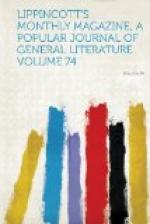Inside the Capitol too there is much to detain you: the vast fireproof library of Congress; the legislative halls; the marble room, wainscoted in mirrors, where you can see the Senators slide between the pillars accompanied by the multiplying train of not one but a hundred shadows, and where you can wonder to your heart’s content what a room lined with looking-glass has to do with legislation; the storied bronze doors, and the bronze staircases hidden away in the dark, in and out the intricacies of whose balustrades all manner of forest-life is cast—the deer bounding beneath the branches, and the birds fluttering over their nests, which the serpent slides along to rifle. In the older portion of the building is the national order of architecture designed by Jefferson, the columns of which are clustered cornstalks, and in whose capitals the acanthus leaf is pushed aside by the curling tobacco. The lower corridors, too, are pictured with representations of our natural history in bird and flower and fruit—far fitter decoration than the swarming cherubs and cupids and numberless unwarrantable little Loves that tumble about on the other walls, intrude themselves on battle-scenes, and hover round the appalling frescoes of Liberty, Law, Legislation and Religion in the President’s room, after a fashion that would be too free and easy for the villa of Lucullus, but which is not altogether discordant with the splendid leprosy of gilding with which the whole interior is infected; which is to be seen oozing from the caissons overhead in huge stalactites, damasked in broad sheets on the paneling, glaring in lattice-work, bosses, scrolls and frets, and trickling everywhere over the efflorescence of the plaster decorations. There are two or three committee-rooms, likewise, very elaborately, though very questionably, decorated, and usually on exhibition to rural visitors, who gape at them with a happy sense of the proprietorship of such pomp. The least unworthy of these is the room set apart for the Committee on Military Affairs: vivid wreaths of laurel decorate the ceiling much more effectively than do the sprawling females of most of the other places; a couple of large battle-pieces illuminate the walls, and cornice, panel and pilaster are simply adorned with frescoed arms and muniments of war. Another is the room of the Agricultural Committee, where, with his group of Romans, Cincinnatus, called from the plough, fills the upper section of one end, and confronts his modern compeer, Israel Putnam; above two side doors little scenes of grain-harvesting illustrate the difference between the old and the new way of going afield; and circling overhead are the Seasons and their attendants—Spring, with armfuls of blossoms and cherubs letting loose the doves; Summer, whose sprites are shooting down arrows of fervid heat; Autumn, with his grapes and sheaves, and his followers festive with lute and tambourine; and old Winter, moving through angry clouds, while his children pour




